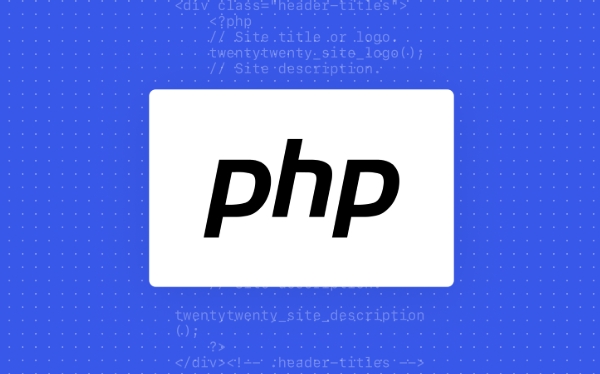how to find the difference between two php array variables
Jul 05, 2025 am 12:09 AMTo compare the differences between two arrays in PHP, you can use the following methods: 1. Use array_diff to compare the differences in values ??and return values ??that exist in the first array but do not exist in other arrays; 2. Use array_diff_assoc to compare keys and values ??at the same time, which is suitable for associative arrays; 3. By calling array_diff separately and merging the results, you can achieve two-way comparison and obtain all different parts of the two arrays; 4. For multi-dimensional arrays or objects, additional processing is required, such as string comparisons using recursive functions, third-party libraries, or JSON encoding. These methods can be selected and used according to actual needs.

When handling PHP development tasks, you often encounter situations where you need to compare two array variables. Finding out the differences between them may be to debug data, synchronize content, or make conditional judgments. PHP provides multiple built-in functions to help us do this quickly without having to manually traverse and compare ourselves.

1. Use array_diff to find out the difference in the value
array_diff() is one of the most commonly used array comparison functions. It compares the values ??in the array one by one and returns values ??that exist in the first array but not in the other arrays.

$array1 = [1, 2, 3, 4]; $array2 = [3, 4, 5, 6]; $result = array_diff($array1, $array2); // Output: [0 => 1, 1 => 2]
- This function only compares values, not keys.
- If you have multiple arrays to compare, you can pass in multiple parameters:
array_diff($arr1, $arr2, $arr3).
Note: If an array contains complex structures (such as subarrays or objects), this function may not work the way you expect, because objects and arrays cannot be compared directly.
2. Use array_diff_assoc to compare keys and values ??at the same time
If you not only want to see if the values ??are different, but also want to check whether the corresponding keys are consistent, you should use array_diff_assoc() .

$array1 = ['a' => 1, 'b' => 2, 'c' => 3]; $array2 = ['a' => 1, 'b' => 9, 'd' => 3]; $result = array_diff_assoc($array1, $array2); // Output: ['b' => 2, 'c' => 3]
- It is stricter than
array_diff(), comparing both values ??and keys. - Suitable for associative arrays or configuration item comparisons.
3. Get completely different parts of two arrays (two-way comparison)
Both functions above are one-way, which means that they only return the extra parts in the first array. If you want to know all the differences between two arrays at the same time, you can do this:
- Call it twice, and then merge the results:
$result1 = array_diff($array1, $array2); $result2 = array_diff($array2, $array1); $full_diff = array_merge($result1, $result2);
This way you can see which side has more values, which are suitable for scenarios where you need a comprehensive understanding of the differences.
4. Comparison of multi-dimensional arrays or objects requires additional processing
The functions mentioned above are very effective for ordinary one-dimensional arrays, but if the array is multidimensional or contains objects, you will be a little overwhelmed. At this time you can:
- Write a recursive function yourself and compare it in depth layer by layer
- Or use some third-party libraries (such as Symfony's VarDumper Comparator)
- In addition, you can convert the array to JSON string first and then compare the string. Although it is not very accurate, you can quickly see the overall changes.
if (json_encode($array1) !== json_encode($array2)) {
echo "The array content is different";
}This method is suitable for rough judgment and is not suitable for fine-grained analysis.
Basically these are the methods. Depending on the type and depth of content you want to compare, just select the appropriate function or combination method. These operations don't seem complicated, but it's easy to ignore details in actual development, especially the matching problem of key names and value types.
The above is the detailed content of how to find the difference between two php array variables. For more information, please follow other related articles on the PHP Chinese website!

Hot AI Tools

Undress AI Tool
Undress images for free

Undresser.AI Undress
AI-powered app for creating realistic nude photos

AI Clothes Remover
Online AI tool for removing clothes from photos.

Clothoff.io
AI clothes remover

Video Face Swap
Swap faces in any video effortlessly with our completely free AI face swap tool!

Hot Article

Hot Tools

Notepad++7.3.1
Easy-to-use and free code editor

SublimeText3 Chinese version
Chinese version, very easy to use

Zend Studio 13.0.1
Powerful PHP integrated development environment

Dreamweaver CS6
Visual web development tools

SublimeText3 Mac version
God-level code editing software (SublimeText3)

Hot Topics
 php regex for password strength
Jul 03, 2025 am 10:33 AM
php regex for password strength
Jul 03, 2025 am 10:33 AM
To determine the strength of the password, it is necessary to combine regular and logical processing. The basic requirements include: 1. The length is no less than 8 digits; 2. At least containing lowercase letters, uppercase letters, and numbers; 3. Special character restrictions can be added; in terms of advanced aspects, continuous duplication of characters and incremental/decreasing sequences need to be avoided, which requires PHP function detection; at the same time, blacklists should be introduced to filter common weak passwords such as password and 123456; finally it is recommended to combine the zxcvbn library to improve the evaluation accuracy.
 PHP Variable Scope Explained
Jul 17, 2025 am 04:16 AM
PHP Variable Scope Explained
Jul 17, 2025 am 04:16 AM
Common problems and solutions for PHP variable scope include: 1. The global variable cannot be accessed within the function, and it needs to be passed in using the global keyword or parameter; 2. The static variable is declared with static, and it is only initialized once and the value is maintained between multiple calls; 3. Hyperglobal variables such as $_GET and $_POST can be used directly in any scope, but you need to pay attention to safe filtering; 4. Anonymous functions need to introduce parent scope variables through the use keyword, and when modifying external variables, you need to pass a reference. Mastering these rules can help avoid errors and improve code stability.
 How to handle File Uploads securely in PHP?
Jul 08, 2025 am 02:37 AM
How to handle File Uploads securely in PHP?
Jul 08, 2025 am 02:37 AM
To safely handle PHP file uploads, you need to verify the source and type, control the file name and path, set server restrictions, and process media files twice. 1. Verify the upload source to prevent CSRF through token and detect the real MIME type through finfo_file using whitelist control; 2. Rename the file to a random string and determine the extension to store it in a non-Web directory according to the detection type; 3. PHP configuration limits the upload size and temporary directory Nginx/Apache prohibits access to the upload directory; 4. The GD library resaves the pictures to clear potential malicious data.
 Commenting Out Code in PHP
Jul 18, 2025 am 04:57 AM
Commenting Out Code in PHP
Jul 18, 2025 am 04:57 AM
There are three common methods for PHP comment code: 1. Use // or # to block one line of code, and it is recommended to use //; 2. Use /.../ to wrap code blocks with multiple lines, which cannot be nested but can be crossed; 3. Combination skills comments such as using /if(){}/ to control logic blocks, or to improve efficiency with editor shortcut keys, you should pay attention to closing symbols and avoid nesting when using them.
 How Do Generators Work in PHP?
Jul 11, 2025 am 03:12 AM
How Do Generators Work in PHP?
Jul 11, 2025 am 03:12 AM
AgeneratorinPHPisamemory-efficientwaytoiterateoverlargedatasetsbyyieldingvaluesoneatatimeinsteadofreturningthemallatonce.1.Generatorsusetheyieldkeywordtoproducevaluesondemand,reducingmemoryusage.2.Theyareusefulforhandlingbigloops,readinglargefiles,or
 Tips for Writing PHP Comments
Jul 18, 2025 am 04:51 AM
Tips for Writing PHP Comments
Jul 18, 2025 am 04:51 AM
The key to writing PHP comments is to clarify the purpose and specifications. Comments should explain "why" rather than "what was done", avoiding redundancy or too simplicity. 1. Use a unified format, such as docblock (/*/) for class and method descriptions to improve readability and tool compatibility; 2. Emphasize the reasons behind the logic, such as why JS jumps need to be output manually; 3. Add an overview description before complex code, describe the process in steps, and help understand the overall idea; 4. Use TODO and FIXME rationally to mark to-do items and problems to facilitate subsequent tracking and collaboration. Good annotations can reduce communication costs and improve code maintenance efficiency.
 Quick PHP Installation Tutorial
Jul 18, 2025 am 04:52 AM
Quick PHP Installation Tutorial
Jul 18, 2025 am 04:52 AM
ToinstallPHPquickly,useXAMPPonWindowsorHomebrewonmacOS.1.OnWindows,downloadandinstallXAMPP,selectcomponents,startApache,andplacefilesinhtdocs.2.Alternatively,manuallyinstallPHPfromphp.netandsetupaserverlikeApache.3.OnmacOS,installHomebrew,thenrun'bre
 Learning PHP: A Beginner's Guide
Jul 18, 2025 am 04:54 AM
Learning PHP: A Beginner's Guide
Jul 18, 2025 am 04:54 AM
TolearnPHPeffectively,startbysettingupalocalserverenvironmentusingtoolslikeXAMPPandacodeeditorlikeVSCode.1)InstallXAMPPforApache,MySQL,andPHP.2)Useacodeeditorforsyntaxsupport.3)TestyoursetupwithasimplePHPfile.Next,learnPHPbasicsincludingvariables,ech






